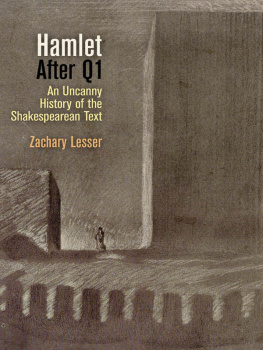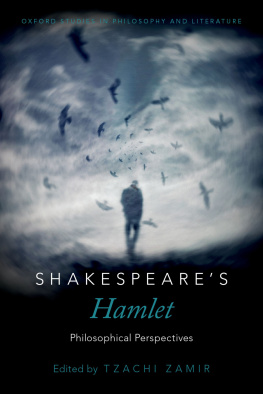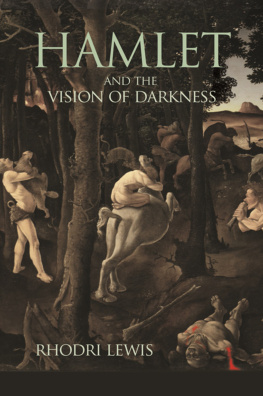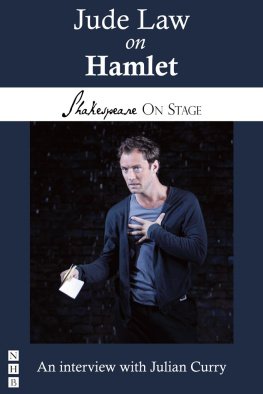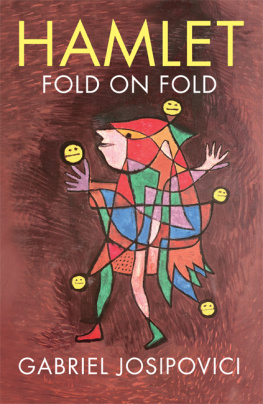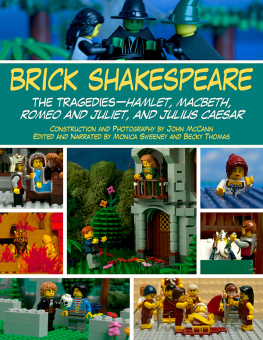
Hamlet
After Q1

Barton Hall, where the first known copy of Q1 was discovered, after it was destroyed by fire in 1914. Reproduced by kind permission of the Suffolk Record Office, Bury St. Edmunds branch, shelf mark HD526/11/9.
Hamlet
After Q1
___________
An Uncanny History of the Shakespearean Text
Zachary Lesser

MATERIAL TEXTS
Series Editors |
Roger Chartier | Leah Price |
Joseph Farrell | Peter Stallybrass |
Anthony Grafton | Michael F. Suarez, S.J. |
A complete list of books in the series is available from the publisher.
Copyright 2015 University of Pennsylvania Press
All rights reserved. Except for brief quotations used for purposes of review or scholarly citation, none of this book may be reproduced in any form by any means without written permission from the publisher.
Published by
University of Pennsylvania Press
Philadelphia, Pennsylvania 19104-4112
www.upenn.edu/pennpress
Printed in the United States of America on acid-free paper
10 9 8 7 6 5 4 3 2 1
Library of Congress Cataloging-in-Publication Data is available. Lesser, Zachary.
Hamlet after Q1 : an uncanny history of the Shakespearean text / Zachary Lesser. 1st ed.
p. cm. (Material texts)
Includes bibliographical references and index.
ISBN 978-0-8122-4661-2
1. Shakespeare, William, 15641616. HamletCriticism, Textual. 2. Shakespeare, William, 15641616BibliographyQuartos. 3. Transmission of textsEnglandHistory17th century. I. Title. II. Series: Material texts.
PR2807.L385 2015
822.3'3dc23
2014025092
For Taije and Raphael Boaz
belated discoveries and endless rarities
The treasures of time lie high, in Urnes, Coynes, and Monuments, scarce below the roots of some vegetables. Time hath endlesse rarities, and shows of all varieties; which reveals old things in heaven, makes new discoveries in earth, and even earth it self a discovery.
Thomas Browne, Hydriotaphia, Urne-Buriall (1658)
Who shall tell what may be the effect of writing? If it happens to have been cut in stone, though it lie face downmost for ages on a forsaken beach, or rest quietly under the drums and tramplings of many conquests, it may end by letting us into the secret of usurpations and other scandals gossiped about long empires ago:this world being apparently a huge whispering-gallery.
George Eliot, Middlemarch (1874), (mis)quoting Urne-Buriall
Genealogy operates on a field of entangled and confused parchments, on documents that have been scratched over and recopied many times.
Michel Foucault, Nietzsche, Genealogy, History (1971)
CONTENTS
Introduction
The Urn-Hamlet
Two centuries after the death of its author, William Shakespeares greatest play was changed forever. In 1823, Sir Henry Bunbury found an old book, a small quarto, barbarously cropped, and very ill-bound, in a closet of the manor house of Great Barton, Suffolk. Or maybe he had found it two years earlier in the library, or in a closet in the library; Sir Henry could never seem to recall. He had recently inherited the manor and was taking an inventory of his new holdings, which fortuitously led him to this book that otherwise might have continued to rest on the shelf unknown and unread. Or maybe he was inspired to scour his shelves for rare books after reading The Library Companion by the self-described bibliomaniac Thomas Frognall Dibdin; so Dibdin claimed, anyway, providing a third possibility for the discovery. Since Barton Hall was destroyed by fire in 1914, it is now impossible to know exactly where this remarkable book was found. But the story I will tell deals repeatedly with loss, destruction, and reconstruction.
Bunburys small quarto contained twelve of Shakespeares plays, nearly all in their first editions, including Romeo and Juliet, The Merchant of Venice, A Midsummer Nights Dream, and several of the histories. Such a compendium would today be worth a fortune, had it not been disbound sometime later in the nineteenth century while in the collection of the Duke of Devonshire, the pages of each play barbarously cropped once again to be inlaid in fine paper and rebound.).

Figure 1. Title page of Q1 Hamlet.
Reproduced by permission of the Huntington Library, San Marino, California, shelf mark 69304
).
In what seems to have been the earliest public report of the discovery, the Literary Gazette told its readers that Q1 contained new readings, of infinite interest; sentiments expressed, which greatly alter several of the characters; differences in the names; and many minor points which are extremely curious.

Figure 2. Title page of Payne and Fosss 1825 reprint of Q1 Hamlet.
Reproduced by permission of the Horace Howard Furness Memorial Library, Kislak Center for Special Collections, Rare Books and Manuscripts, University of Pennsylvania Libraries, shelf mark PR2750.B07 1825.
If in fact Hanmer ever owned the volume, then he too had not understood its importance: had he known that it contained the sole exemplar of a remarkably different text of Hamlet, presumably he would have mentioned it in his edition. Like so much else about Q1, exactly how this book made its way into Bunburys closet remains a mystery. About its history prior to Payne and Fosss 1825 reprint, we have only shadowy guesses.
The entire textual history of Hamlet is haunted by bibliographic ghosts. Repeatedly, new archival finds offer tantalizing hints of texts that no longer exist, if they ever did, and of lineages that can no longer be traced. In the middle of the eighteenth century Richard Farmer found the earliest recorded mention of the play, Thomas Nashes satirical comment in 1589 that English Seneca read by candlelight helps unlearned dramatists patch together whole Hamlets, I should say handfulls of tragical speaches.
Partly for this reason, it was largely ignored before the discovery of Q1. It is remarkable how little commentary the German play generated in the decades after its initial publication; Malone, for instance, makes no mention of the text anywhere in his edition, nor does Isaac Reed in his editions (1803, 1813), nor James Boswell in his revision of Malone (1821). By the mid-nineteenth century, however, once scholars could see that it shared some odd features with Q1, Brudermord could no longer be so easily dismissed. Whereas these editors had remained completely silent about the German play, a century later entire books were devoted to its relationship to Q1.
Together, these textual traces have conjured up the so-called Ur-Hamlet, a pre-Shakespearean drama that survives, if in fact it survives at all, only in the single phrase quoted by Lodge: Hamlet, reuenge. As Emma Smith remarks, despite the unfortunate detail of its nonexistence, the text of this phantom play has been variously deduced, discussed and even edited by textual scholars, fabricated from portions of
Next page
